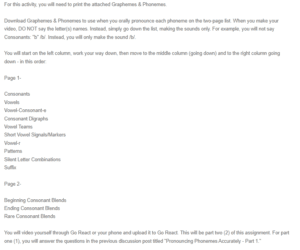Pronouncing Phonemes Accurately
During my pronunciation practice for all phonemes in the English language, I encountered several challenges in different categories of the phonemes. Among the consonants, the hardest sounds were s, z, x, l, and r. I often confuse the s and z sounds. I also had difficulty pronouncing some consonant digraphs, including th and wh. Differentiating the various sounds of vowel-r was also a significant challenge. I often interchange the vowel-r sounds. Most of the consonant blends also posed significant challenges in pronouncing them.
The phonemes pronunciation exercise enlighten me on my weakness and the areas that need improvement. To enhance my pronunciation accuracy, I will focus on my listening skills to learn from other people’s ways of intonation. I will watch videos demonstrating how phonemes are pronounced (Rachmawati & Cahyani, 2020). Numerous video tutorials explain how to make different sounds. I also intend to use online dictionaries, which give access to sounds by clicking on specific words and listening to them being pronounced. Further, I will practice regularly on how to make the sounds since the more I practice, the higher the accuracy rate of pronunciation.
A reading teacher needs to have better articulation of phonemes since it is a fundamental concept in teaching phonics and phonological awareness to students to improve their reading and writing skills. Phonemes are the building blocks of words. Hence, better articulation of phonemes improves students’ ability to read, write, and understand comprehension (Ehri, 2022). Teachers have a critical role in students’ language skills development. Thus, if the teacher cannot articulate phonemes correctly, it may result in mispronunciations among students, hampering the effectiveness of their language skills. Reading teachers should be instrumental in building a strong foundation for students’ language and literacy development.
References
Ehri, L. C. (2022). What teachers need to know and do to teach letter–sounds, phonemic awareness, word reading, and phonics. The Reading Teacher, 76(1), 53-61. https://doi.org/10.1002/trtr.2095
Rachmawati, R., & Cahyani, F. (2020). The use of YouTube videos in improving non-English Department students’ pronunciation skills. Alsuna: Journal of Arabic and English Language, 3(2), 83-95. https://doi.org/10.31538/alsuna.v3i2.916
ORDER A PLAGIARISM-FREE PAPER HERE
We’ll write everything from scratch
Question

Pronouncing Phonemes Accurately
For this activity, you will need to print the attached Graphemes & Phonemes.
Download Graphemes & Phonemes to use when you orally pronounce each phoneme on the two-page list. When you make your video, DO NOT say the letter(s) names. Instead, simply go down the list, making the sounds only. For example, you will not say Consonants: “b” /b/. Instead, you will only make the sound /b/.
You will start on the left column, work your way down, then move to the middle column (going down) and to the right column going down – in this order:
Page 1-
Consonants
Vowels
Vowel-Consonant-e
Consonant Digraphs
Vowel Teams
Short Vowel Signals/Markers
Vowel-r
Patterns
Silent Letter Combinations
Suffix
Page 2-
Beginning Consonant Blends
Ending Consonant Blends
Rare Consonant Blends
You will video yourself through Go React or your phone and upload it to Go React. This will be part two (2) of this assignment. For part one (1), you will answer the questions in the previous discussion post titled “Pronouncing Phonemes Accurately – Part 1.”
This video assignment should show an understanding of the content and your ability to teach these skills to students. That means that you should show the correct pronunciation of all phonemes (speech sounds) and the correct placement of lips, teeth, and tongue. You should demonstrate a good pace that a child can follow and learn from. You should provide enough emphasis on the speech sounds. Your video should be a professional demonstration. That means absolutely NO background noises, a clear wall behind you, and a professional appearance of yourself (including dress and how your camera is angled to viewers). Your video should not be longer than 5 minutes, so make sure that you have practiced (before going on camera).

